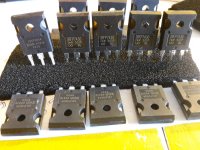Thanks wdesho and ZM! 
This little IRF3706 really grows on me. I am listening to Ray Charles - Genius loves company, in 24/192 hd, and it is very nice. I might long for the raw brutal superabundant level of joyous fun the IRLB3813 delivers, but there is no denying that the IRF3706 is a very nice little mosfet for source-follower duty within its quite limited voltage and heat-transfer capacity.
Since the IRF3706 went out of production some time ago, I searched for some suitable replacement with reasonable similar characteristics. The best alternative I found is the IRL3103: http://www.irf.com/product-info/datasheets/data/irl3103.pdf
The IRL3103 has a 30 volt rating and a slightly more interesting transfer curve.
It is a nice little device with an even nicer price. If anyone wants to try it please observe the rather high thermal resistance. I would not run more then 12 volts and 1.2 ampere through it.
If anyone wants more character (increased fun-factor - vivid open and "alive") then the IRF3711 and IRFP7430 should provide more then enough of this quality.
Cheers,
Johannes
This little IRF3706 really grows on me. I am listening to Ray Charles - Genius loves company, in 24/192 hd, and it is very nice. I might long for the raw brutal superabundant level of joyous fun the IRLB3813 delivers, but there is no denying that the IRF3706 is a very nice little mosfet for source-follower duty within its quite limited voltage and heat-transfer capacity.
Since the IRF3706 went out of production some time ago, I searched for some suitable replacement with reasonable similar characteristics. The best alternative I found is the IRL3103: http://www.irf.com/product-info/datasheets/data/irl3103.pdf
The IRL3103 has a 30 volt rating and a slightly more interesting transfer curve.
It is a nice little device with an even nicer price. If anyone wants to try it please observe the rather high thermal resistance. I would not run more then 12 volts and 1.2 ampere through it.
If anyone wants more character (increased fun-factor - vivid open and "alive") then the IRF3711 and IRFP7430 should provide more then enough of this quality.
Cheers,
Johannes
Finally!!
Now I have some new, strange and exciting toys to play with.
My wife forces me to start laminating epoxy and fiberglass on the rudder for our sailboat, when all I want to do is build amplifiers...
Sure I like sailing too, but I have been longing for these transistors for some time now..
Cheers,
Johannes
Now I have some new, strange and exciting toys to play with.
My wife forces me to start laminating epoxy and fiberglass on the rudder for our sailboat, when all I want to do is build amplifiers...
Sure I like sailing too, but I have been longing for these transistors for some time now..
Cheers,
Johannes
Last edited:
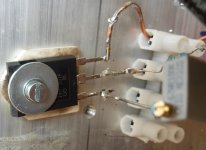
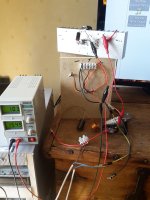
Another one of my perfect builds.
Well this is a surprise!
I had expected almost anything except this...
It is just clean and smooth. There is the same direct vivid presence the IRFL3813 has, but it is actually a lot smoother and nicer sounding overall. I am running the IRFP7430 with 1030 mA and 12,7 volts Vds as a source follower with a 32 mH air-cored coil as load.. I guess it would sound much better at 20 volts and 2 ampere.
I use a 33 ohm gate stopper and the treble is much much better.
Over all I am very impressed.
Cheers,
Johannes
After a few more hours of listening to this quite extreme low voltage, high current, strange transfer-curves device I am more then impressed. This is by far the best sounding mosfet in a simple source-follower amp I have ever heard. It has a more lively immediate presence then the IRLB3813, without any of the sometimes coarse and brutal presentation the old IRLB3813 has. It is smooth, but at the same time has an unlimited power and command of whatever music it has to coax out of my BIB. It has this very difficult to describe character of an immediate, unhindered organic effortless and present flow that I usually associate with really good single end class a triode amplifiers.
Based on this first simple and crude test I dare to proclaim this my new favorite transistor for single ended class a linear analog amplification...
Now I need to test this transistor in the PCF-Zen amp. With PCF it will probably be quite brutal and exciting with some real muscle to control the very reactive load a loudspeaker is.
Very very exciting!!!

Cheers,
Johannes
Based on this first simple and crude test I dare to proclaim this my new favorite transistor for single ended class a linear analog amplification...
Now I need to test this transistor in the PCF-Zen amp. With PCF it will probably be quite brutal and exciting with some real muscle to control the very reactive load a loudspeaker is.
Very very exciting!!!
Cheers,
Johannes
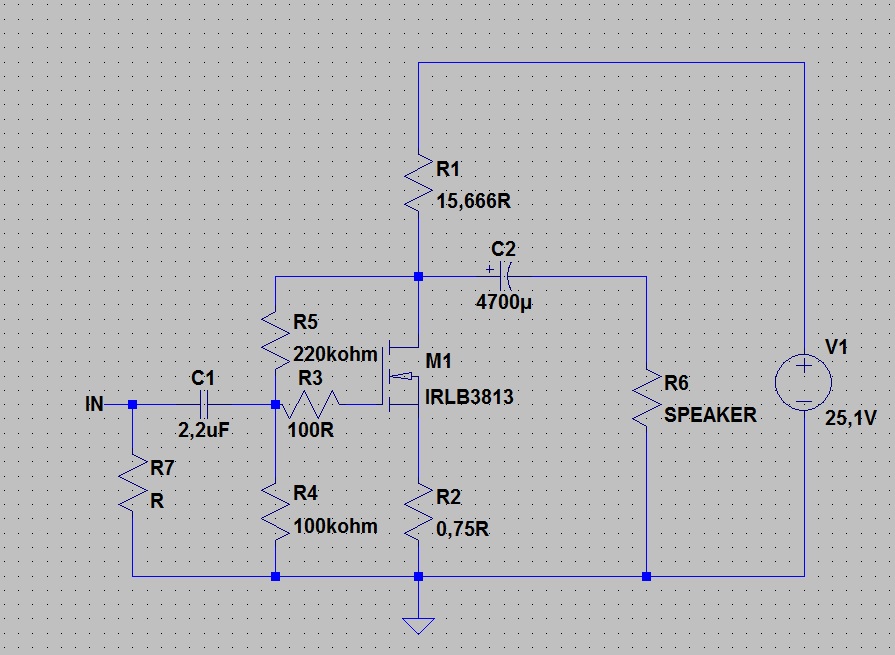
I built this amp but with 28 volt power supply and an IRFP7430 instead of the IRLB3813. It is the same device as in the previous post, but I removed the large inductance from the source and soldered a bunch of 47 ohm 7 watt power resistors as a 15.66 ohm drainload.
R2 is 0.5 ohm (local source degeneration).
It is a very interesting device!!!
All the frightening capacitance in the data sheet seems to be quite easy to drive from my M-Audio soundcard. The treble is smooth and nice. The very vivid lifelike presence is even more pronounced. It might be a bit heavy-handed in the very powerful presentation of music. There is nothing remotely polite, humble or cautious with this transistor. If a IRFP150 is like a nice 2010 Volvo V70, then the IRLB3813 is like a supercharged Dodge Viper and this IRFP7430 would be a Top Fuel dragster. It is the Saturn V when the rest of the devices I have tried is nice consumer fireworks.
It seems to have a high damping factor considering the total lack of global feedback. Compared to the same circuit with a IRFP150 the bass is very well defined without any bloat or warmth associated with the low damping factor from simple no global feedback amp.
This is very interesting!
If my impression and experience so far is correct then I guess we have a cheap SIT-ish device available from IR as an active and preferred part.
https://youtu.be/7XeG1h3sG8s?t=2986
At 49 minutes and 50 seconds to 50 minutes and 40 seconds Nelson Pass talks about the ohmic or linear region of fets. "Some of them have broad ones and some of them do not".
The IRFP7430 seems to be one of those with a very broad linear/ohmic regions.
It does have a lot of gate-capacitance, which is an important thing to consider when designing the drive circuit. It would be a "nice little challenge" to design a lean running, linear and smooth sounding class a/b amp with the IRFP7430...
Cheers,
Johannes
At 49 minutes and 50 seconds to 50 minutes and 40 seconds Nelson Pass talks about the ohmic or linear region of fets. "Some of them have broad ones and some of them do not".
The IRFP7430 seems to be one of those with a very broad linear/ohmic regions.
It does have a lot of gate-capacitance, which is an important thing to consider when designing the drive circuit. It would be a "nice little challenge" to design a lean running, linear and smooth sounding class a/b amp with the IRFP7430...

Cheers,
Johannes
Good work and very entertaining, Johannes.
Another minute into that video I point out the biggest problem, which is
that the capacitance is high. As an example, the IRLB318 has a Ciss of
about 8nF and a Crss of about 0.8 nF.
For the (easily calculated) example of 20 dB gain, the Crss looks like 8nF,
and if you add that to the Ciss of 8 nF and you have 16 nF.
Not that any of this will faze the members of FAB*

*Fearless Amplifier Builders. Get with it and join today!
Another minute into that video I point out the biggest problem, which is
that the capacitance is high. As an example, the IRLB318 has a Ciss of
about 8nF and a Crss of about 0.8 nF.
For the (easily calculated) example of 20 dB gain, the Crss looks like 8nF,
and if you add that to the Ciss of 8 nF and you have 16 nF.
Not that any of this will faze the members of FAB*
*Fearless Amplifier Builders. Get with it and join today!
I have seen some comment about this lack of bass with the Cree C3M0065090D..
It is strange. I don't understand why they behave this way.
Except for the lack of bass it sounds very very nice.
My idea (just an idea) here is that when you use the Cree you're getting poorer rejection of power supply noise. Take a peek at the curves and compare with a normal MOSFET. The SiC parts have no straight lines to the right (the saturation region).
Good work and very entertaining, Johannes.
Not that any of this will faze the members of FAB*
Thanks Nelson Pass!!!
No! Some scary gate capacitance should not stop us from exploring exciting new devices.
Your simple and humorous but utterly brilliant sentence from the Zen V.8 article
has really inspired me. Just redefine boring and negatively impedimental "problems" to positive encouraging "opportunities" and we are back in business.Our problems (hereafter referred to as opportunities) are fairly simple
You have often shown that what superficially can be seen as a problem can easily become a opportunity with some creative thinking.
Cheers,
Johannes
when you use the Cree you're getting poorer rejection of power supply noise
I don't think the choice of gain-device has much effect on the power supply noise rejection in this circuit, but the Cree SiC fets seems to lack transconductance at lower voltages and currents. They behave like very high voltage low transconductance mosfets (which is what they are).
After playing with them in some different circuits I am quite disappointed. They can sound very nice in the mid and treble, and I want to test them in some high voltage transformer-coupled amps where I believe they can perform very well. At the moment I prefer to explore the IRFP7430 since it is a very interesting device in many ways.
I focus much more on the contrasts and dynamic aspects of music reproduction since it is the dynamic aspects that transmits the experience of joy and life. An amplifier - no matter how clean and smooth - will never be much fun if it is to dull and laid back. I want a very open dynamic and vivid character, and I am prepared to accept some coarseness at higher frequencies to get this life-like, vigorous and stirring quality.
With the Pass SIT-1 you can obviously have it all.

It is a shame SemiSouth did not start mass produce SiC-SITs and sell them through Mouser at a nice price.
Cheers,
Johannes
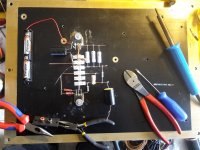
Today I am building something a little more thought through, serious and meant to be somewhat semi-permanent.
It is an IRFP7430pbf in a Zen amp with no global negative feedback, with a battery-biased IRLP3034pbf as a constant current source.
There is 0,5 ohm source degeneration on the IRFP7430.
I hope I can test it soon. Maybe it will become a two channel amp next week.
Cheers,
Johannes
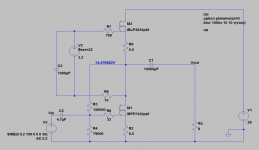
This is the exact circuit that is playing in my living room at the moment.
I am playing Drums around the corner by Art Blakey and I am having a lot of fun listening to this!!
It might not be the ultimate in analytical high definition high fidelity amplification, but is very very fun!
There is a lot of character, but I have heard commercial tube-amps sounding much worse then this.
If this device has transfer curves even remotely reminiscent of the Pass SIT1, then I think I understand why Nelson Pass used a simple power-resistor as the drain-load in his FW SIT amps.
A constant current source does not load or stress the gaindevice in the same way as a power resistor. In my very short and limited experience with this device, I have found that it "likes" having to do some serious honest work. With the very large resistance and constant current seen from the CCS the character is exaggerated.
Nelson Pass writes about this in one of his articles, but I can't find it now. He is a very brillliant designer. I am very grateful for all the knowledge he shares with us! It makes it so much easier to understand what is happening when experimenting with these strange devices and these simple class A amplifiers. The IRLB7430 without negative global feedback really needs some source-resistance. With 0,5 ohm it is quite aggressive and peculiar. I am tempted to use a few dB global negative feedback, but because of the huge gate capacitance I would be forced to add an input buffer of some kind.
There is always a trade-of with everything. Often a multidimensional complex network of trade-offs.... Fun, but always challenging....
Ohh! Did I mention the bass coming from this amp and my BIBs???

Cheers,
Johannes
You have got to be kidding me!Maybe it will become a two channel amp next week
That's it, I'm bringing out the popcorns, this is the first time you gone stereo since the great fire of the Kalmar straight, very happy to hear this, oh how I've waited for this
- Status
- This old topic is closed. If you want to reopen this topic, contact a moderator using the "Report Post" button.
- Home
- Amplifiers
- Pass Labs
- Why IRLB3813 and similar (strange) low voltage devices?!
